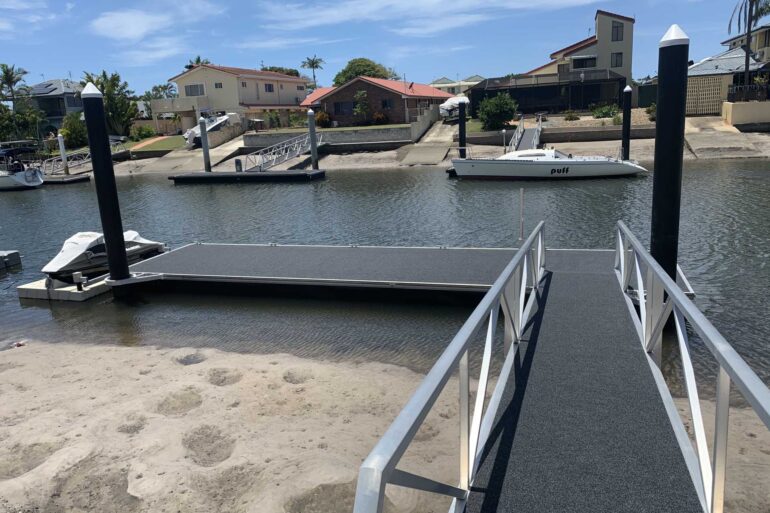
If you’re considering having a dock installed on your waterfront property, then the decision needs careful consideration.
As pontoon manufacturers and pontoon repair specialists, we see all kinds of docks installed on waterfront homes across the Gold Coast, Sunshine Coast, Brisbane, and Northern NSW regions – the regions that we service. While each provides the same function, that being, a structure for moored boats to dock to, they all differ in one way or another.
In terms of mooring structures, there are two main categories – floating docks and fixed docks. As mentioned, each provides the same function, but they have distinct differences, and one presents clear advantages over the other.
Today, we take a look at floating docks and fixed docks. We’ll look at the types of docks available for each and identify their pros and cons.
Floating Docks
Floating docks are by far the preferred dock of choice today. They are generally fixed in position horizontally but can move vertically – up and down – with the tide. They provide a durable platform for docking boats, jet skis and PWCs, and easy access for people to enter their vessel.
Floating docks come in many forms, including jet ski docks, floats, barges, marina docks, and gangways and ramps, but the most popular of all are pontoons, which we specialise in here at Micks Marine Maintenance.
Pontoons’ popularity stems from their many benefits. They’re generally made from aluminium and provide great longevity in marine environments. Thus, they have low maintenance requirements, and if maintenance is required, it is minor and easy to repair. Moreover, pontoons are usually more affordable than fixed docks, and due to their mobility, moored boats fare better in torrential rainfall where a river bursts its banks.
Pontoons come in various types, including piled pontoons, strut pontoons and cable pontoons, which you can learn more about on our Pontoon Sales page.
Fixed Docks
Fixed docks, also referred to as stationary docks, are fixed, immovable objects. They serve to provide a platform for boats and vessels to moor to and convenient access for people to move between the shore and their boat.
The most common and popular type of fixed dock is a jetty, which is generally constructed from timber. Boardwalks are another form of a fixed dock. Jetties and their counterparts provide a robust structure that fares well in waterways with a high level of watercraft activity and current. However, on the flip side, they fare poorly in fluctuating water levels and torrential rainfall. They may become completely submerged and suffer severe damage.
The other major issue with jetties is their high maintenance requirements. Timber doesn’t fare as well as aluminium in water. It will rot over time and require constant repairs once the wood starts to deteriorate.
Conclusion
When it comes to choosing a dock for waterfront homes in the regions of Gold Coast, Sunshine Coast, Brisbane, and Tweed, there is much to consider. It’s important to understand that there are two types of docks, fixed docks and floating docks, but one offers significant advantages over the other – floating docks.
Floating docks, such as pontoons, float on the water, moving vertically, adapting to the tides. On the other hand, fixed floats are stationary – they don’t move vertically or horizontally. This is the primary difference between the two that makes all the difference. Due to the floating nature of pontoons, they last longer and cause less damage to moored boats during torrential rains when tides rise significantly.
If you’re interested in investing in a floating pontoon dock, look no further than Micks Marine Maintenace. As mentioned, we’re pontoon manufacturers, and we also specialise in the maintenance and repair of pontoons across the Gold Coast, Sunshine Coast, Brisbane, and Tweed regions. Therefore, you can rest assured we’ll be here for you over the lifetime of your pontoon.
Call our friendly team today on 0431 778 468 to arrange a quote.